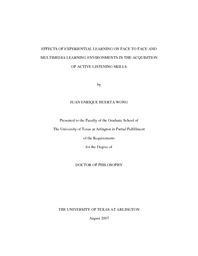
ATTENTION: The works hosted here are being migrated to a new repository that will consolidate resources, improve discoverability, and better show UTA's research impact on the global community. We will update authors as the migration progresses. Please see MavMatrix for more information.
Show simple item record
| dc.contributor.author | Huerta Wong, Juan Enrique | en_US |
| dc.date.accessioned | 2008-04-22T02:41:16Z | |
| dc.date.available | 2008-04-22T02:41:16Z | |
| dc.date.issued | 2008-04-22T02:41:16Z | |
| dc.date.submitted | August 2007 | en_US |
| dc.identifier.other | DISS-1853 | en_US |
| dc.identifier.uri | http://hdl.handle.net/10106/678 | |
| dc.description.abstract | Comparison studies between Technology or Multimedia Learning Environments and Face-to-Face (F2F) Learning Environments in social work education usually show that technology works as well as F2F environments. However, they also suggest they are not interchangeable, but are dependent upon educational approaches. Otherwise, experiential learning as a main educational approach has been adopted from Council on Social Work Education (CSWE) guidelines without strong evidence of its effectiveness. A 2X2 Nonrandomized Multiple Comparison Groups Design with pretest from each group evaluates the effectiveness of two different Learning Environments (multimedia versus F2F) and two different Teaching Techniques (experiential versus exposure plus discussions) in acquiring active listening social work skills. The study used a double blind procedure with blind instructors and external raters of the acquisition of social work skills. A first group of hypotheses proposed that Experiential Learning would be more effective than Exposure plus Discussions in terms of satisfaction, perception of learning gains, and learning and skills acquisition. A second group of hypotheses proposed that Multimedia would be more effective than F2F learning in terms of satisfaction and perception of learning gains, but not on learning or skills acquisition. A third group of hypotheses proposed an interaction between Teaching Techniques and Learning Environments, a Multimedia learning environment being more effective depending on Teaching Technique. It was hypothesized that Multimedia would be more effective whether using Experiential Learning. Multiple Analysis of Variance and Analysis of Covariance were used to analyze the data. Most of the hypotheses were supported, but interaction showed that F2F learners got the highest scores using Experiential Learning. In other words, the most important hypothesis failed to be supported, in fact, the opposite occurred. An alternative explanation for this opposite finding could be attributed to lack of adequate sophistication when designing the multimedia learning environment. A general conclusion is that Experiential Learning seems a plausible Teaching Technique in learning listening skills for social services practice. | en_US |
| dc.description.sponsorship | Schoech, Richard | en_US |
| dc.language.iso | EN | en_US |
| dc.publisher | Social Work | en_US |
| dc.title | Effects Of Experiential Learning On Face To Face And Multimedia Learning Environments In The Acquisition Of Active Listening Skills | en_US |
| dc.type | Ph.D. | en_US |
| dc.contributor.committeeChair | Schoech, Richard | en_US |
| dc.degree.department | Social Work | en_US |
| dc.degree.discipline | Social Work | en_US |
| dc.degree.grantor | University of Texas at Arlington | en_US |
| dc.degree.level | doctoral | en_US |
| dc.degree.name | Ph.D. | en_US |
| dc.identifier.externalLink | https://www.uta.edu/ra/real/editprofile.php?onlyview=1&pid=622 | |
| dc.identifier.externalLinkDescription | Link to Research Profiles | |
Files in this item
- Name:
- umi-uta-1853.pdf
- Size:
- 1.301Mb
- Format:
- PDF
This item appears in the following Collection(s)
Show simple item record


